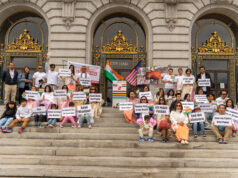By Dr. Malem Ningthouja
CPDM Statement on the occasion of the commemoration of Manipur Women’s War 1939
On the occasion of the commemoration of the Manipur Women’s War 1939 on 12 December, the Campaign for Peace & Democracy (Manipur) hails high the historical resistances that the women of Manipur had carried out during the British colonial period. At the same time, CPDM acknowledges and pays homage to the courage, commitment and selfless contribution of the women democratic forces in Manipur who are fighting injustice and asserting democratic rights. May your democratic voices spread across the borders and be remembered in the canon of resistance history.
To recollect, it was on this day, in 1939, that a bulk of aggrieved women in the capital Imphal, largely composed of famine affected petty-traders, launched an agitation to immediately impose an embargo on the British policy of exporting rice which had created the famine. In the following months, agitation became widespread and targeted British Indian monopoly traders (Marwaris), rice mills owned by them and their local rice suppliers. The agitation added to the tempo of rural anti-tax agitations and it culminated into a popular struggle for a responsible government. The December event came to be known as the Second Women’s War; the first being occurred in 1904, when women rose in agitation to boycott colonial punitive measures directed against recalcitrant princes and collective forced labour imposed on men to avenge certain sporadic ‘incendiarism’. In all these events of 1904, 1939 and the Zelianrong movement under the leadership of Gaidinliu from 1931 onwards, women had played leading roles.
After the annexation of Manipur by India in 1949, the latter’s geo-strategic-market interests and ‘national’ security concerns have created a situation of misrule and humiliation amongst the Manipur patriots. Many women could not remain unaffected when; (a) their ‘nation’ was subdued and denied statehood (1950- 1971); (b) Kabow Valley was arbitrarily ceded away to appease a neighbouring country (1953); (c) there was militarisation and violation of human rights (e.g., Armed Forces Special Powers Act in 1958 and other repressive laws); (d) there was underdevelopment and capture of market by the ‘outside’ market forces; (e) unregulated immigrants were causing negative impacts on land ownership, labour market and ‘indigenous’ culture; (f) there were displacement and destruction as land and natural resources were no longer under their ‘social’ control; (g) divisive policies were creating communal tensions and sectarian conflicts, and; (h) the peoples were subjected to corruption, oppression and misrule by the local regimes composed of the parasitic rentier bourgeoisies that were are promoted and protected by Delhi regime.
Against the backdrop of the scenario, many women took up arms to join insurgency to fight for their respective ‘sovereign’ ‘nationhood’. Some of them became ‘martyrs’ at young age and some others are in the jails. Several innocent women fought against tortures and penalties, arbitrarily imposed on them because each was either a ‘suspect’ or her husbands (if not fiancée) were an insurgent or she was sympathetic to the cause of insurgency. Many women whose husbands or children or dear ones or relatives were forced disappeared or killed or incapacitated in fake encounters are fighting for justice. Many women who are organised into human rights vigilant groups and civil society organisations are fighting injustice and for the protection of human rights. At the same time, many women (including school and collegiate students) who are on the forefront of popular agitations for social, economic and political rights were either killed or wounded or disabled in brutal police repressions.
Although the tradition of resistance prevails; the women’s democratic forces operate in a fragmented society that is disunited due to vested ethnic (communal), party, partisan, sectarian, individual and political interests. Women’s resistances and democratic assertions, therefore, occurred in different regions in different times and led by different forces; thereby, sporadically organised, localised, sectarian, and some of them ended with self-defeating tactics. There is no unified command structure; no common ideological, strategic and tactical position to strive for a collective goal across communities, sections, and regions. Inasmuch as there is lack of internal cohesion, there is also lack of ‘internationalism’ as many do not endeavour to relate their struggle with the international movement against imperialism, neo-liberal exploitation and local reactions; except some breakthrough in internationalisation of certain selective issues by the NGO networks that operate within the framework of international human rights movement.
Despite weaknesses and shortcomings; women’s resistances against misrule and struggles for justice at different layers, locations, sectors, times and issues constitute a general trend that deserves commendation. Instead of being completely fallen to become silently submissive to injustice, there are women who resist and fight for justice in their own ways. Their actions exemplify progressive role; as these expose the bourgeoisie misrule, keep the spirit of resistance alive, and pose some forms of threat to the regime. We valorise these resistances with the hope that these can keep the door open to future consolidation of common goal towards building a society free from subjugation, exploitation and oppression.
Long live Women’s War 1939
Solidarity to the Manipur Women’s Democratic Struggle











